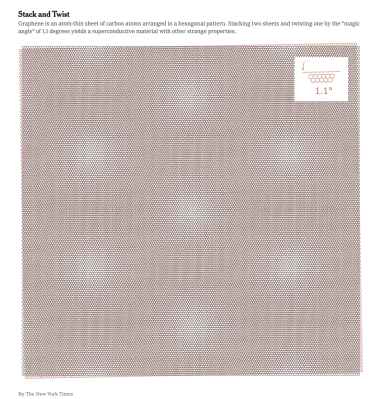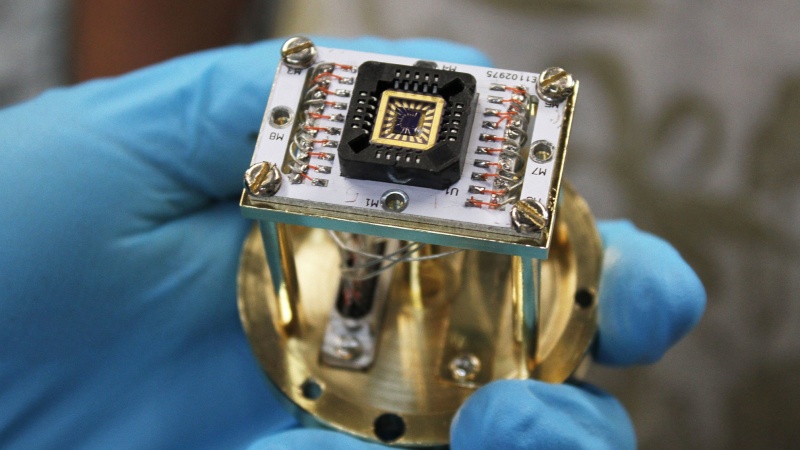In the world of physics research, graphene has been gaining popularity as one of the most remarkable materials in the last 15 years. While it may appear unassuming in common household goods such as pencil leads, the material boasts a higher strength than steel and a higher flexibility than paper. On top of all that, it is also ultra-light and an excellent conductor of electric current and heat.
Recently, physicists from the Massachusetts Institute of Technology discovered that stacking two sheets of graphene and twisting a small angle between them reveals an entire new field of material science – twistronics. In a paper published in Nature, researchers have taken a look into this new material, known as the magic-angle twisted bilayer graphene. By modifying the graphene’s temperature, they were able to cause the material to shift from behaving like an insulator to transforming into a superconductor.
A graphic in the New York Times demonstrates some of the interesting properties that arise from stacking and twisting two sheets. Scientists have long known that graphene is a one-layer-thick honeycombed pattern of carbon atoms, but actually separating a single sheet of graphene has been fairly difficult. A low-tech method pioneered by two physicists at the University of Manchester involves using sticky tape to pull apart graphene layers until a single layer is left.

Small imperfections that arise from slightly misaligned sheets manifests in a pattern that allows electrons to hop between atoms in regions where the lattice line up, but unable to flow in regions that are misaligned. The slower moving electrons are thus more likely to interact with each other, becoming “strongly correlated”.
The technique for measuring the properties of this new twisted graphene is similarly low-tech. After a single layer of graphene is separated by sticky tape, the tape is torn in half to reveal two halves with perfectly aligned lattices. One of the sides is rotated by about 1.3 degrees and pressed onto the other. Sometimes, the layers would snap back into alignment, but other times they would end up at 1.1 degrees and stop rotating.
When the layers were cooled to a fraction of a degree above absolute zero, they were observed to become a superconductor, an incredibly discovery for the physicists involved in the experiment. Further studies showed that different permutations of temperature, magnetic field, and electron density were also able to turn the graphene into a superconductor. On top of this, the graphene was also able to exhibit a form of magnetism arising from the movement of electrons rather than the intrinsic properties of the atoms. With so many possibilities still unexplored, it’s certain that twistronics will reveal some remarkable findings pretty soon.
[Thanks Adrian for the tip!]
















While covalent carbon structures may appear unassuming in common household goods such as pencil leads, graphene boasts a higher strength than steel and a higher flexibility than paper.
Perhaps?
From the description I get the impression that this discovery is serendipitous.
What are the environmental concerns? I won’t believe anyone that says anything less that “hazardous” until actual investigations of this are completed. Plastic was said to be environmentally safe but it’s showing large environmental impacts and we can’t afford another such corporate push without verified and confirmed data.
checkout hemp graphene
“Plastic was said to be environmentally safe but it’s showing large environmental impacts”
This reminds me of “unbreakable toy is ideal for breaking other toys”. I mean, plastics was useful because it was standing out as environment-proof, and it is exactly that characteristic that makes it harmful for environment. Somewhat similarly, each material or thing with outstanding “magical” property will inevitably cause harm (well, profound change), ultimately. The problem doesn’t start when we realize the consequences, but when we fail to anticipate the big picture, or fail to think end before we start. We need to think differently about problems and to make peace with limitations inherent in acceptable solutions space.
“From the description I get the impression that this discovery is serendipitous.”
Perhaps an example of why it’s not always safe to draw conclusions from cursory descriptions? But even if the discovery was serendipitous, what’s your point? Many discoveries that have profoundly improved life were originally made by chance.
As for environmental impact, you do realize that the computer you’re reading HAD on, the car you drive to work in, the house/apartment you live in all contain and involve in their manufacture many environmentally unfriendly substances and processes? Considering graphene is literally just a single atom thick lattice of carbon atoms, your focus on environmental concerns seems highly disproportionate. Your argument is akin to an obese, chain smoking diabetic railing against the health concerns of artificial sweeteners.
And if man didn’t develop any technology until every potential long term environmental concern was fully understood and quantified, we’d still be debating the domestication of animals for crying out loud.
You keep using this word, “plastic”.. but I don’t think it means what you think it means.
Multi-Walled Carbon Nanotubes with built-in angle 1.1
I think rotation will yield even more surprises:
https://www.youtube.com/watch?v=QAja2jp1VjE
Wow!
Let me fix that for you: “In the world of physics research, graphene has been gaining NOTORIETY as one of the most OVERHYPED materials in the last 15 years.”
Maybe this discovery says more about moire patterns than Graphene.
I get it, it’s a new form of superconductor, BUT, how useful is yet another super low temperature superconductor???
I guess it could lead us to looking for graphene structures in other materials and trying this trick with them to get it up to somewhere more useful, like boiling N2 temperature, or CO2 even.
Next, I’d wanna try something like spraying copper oxide on graphene, peeling the graphene off and tryna stick two of those together at the magic angle.
Other people’s money. One gets the impression they have no idea how to scale this for industry.
This is basic research. It isn’t supposed to be commercially valuable in and of itself, it is unlocking new understanding. So yes, it is research grants, and yes they don’t have intent to commercialise it, but no that’s not a weakness.
They are exploring a new and convenient way to control sub-nanometer interactions at a macro scale. Just like research into masers never foresaw commercial applications of lasers like the CD industry or laser manufacturing, and wasn’t even generating photons of light. But the understanding and confirmation of principles unlocks the possibility of future applications.